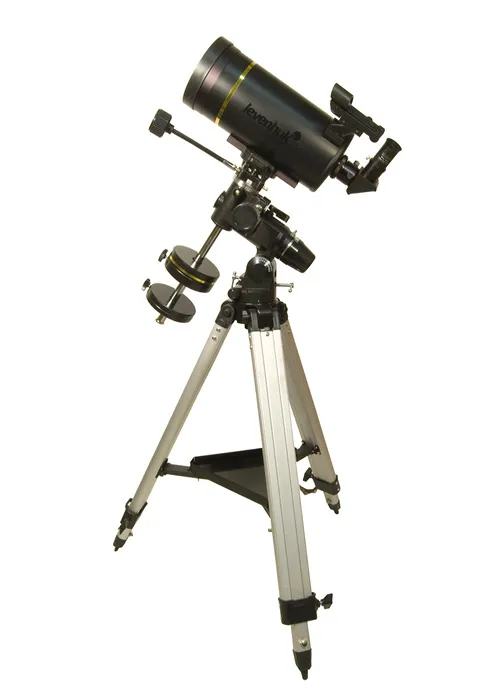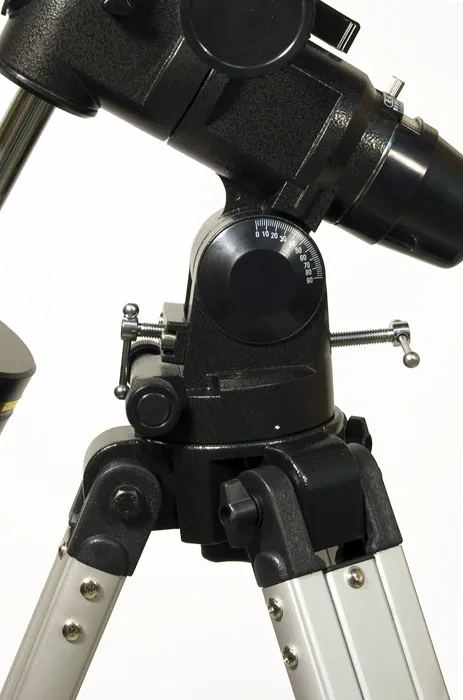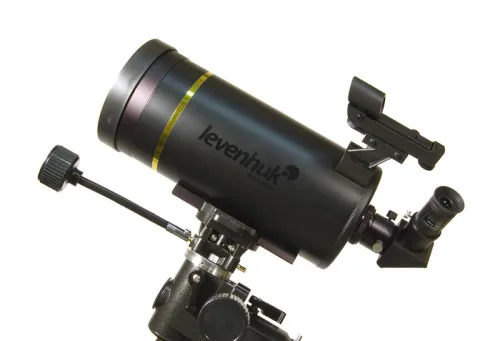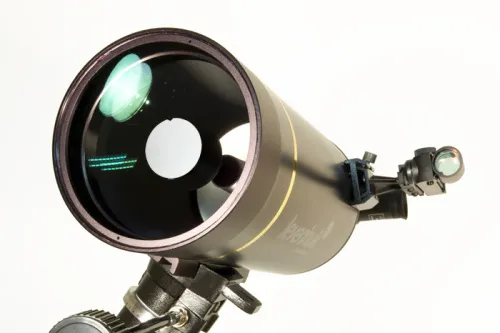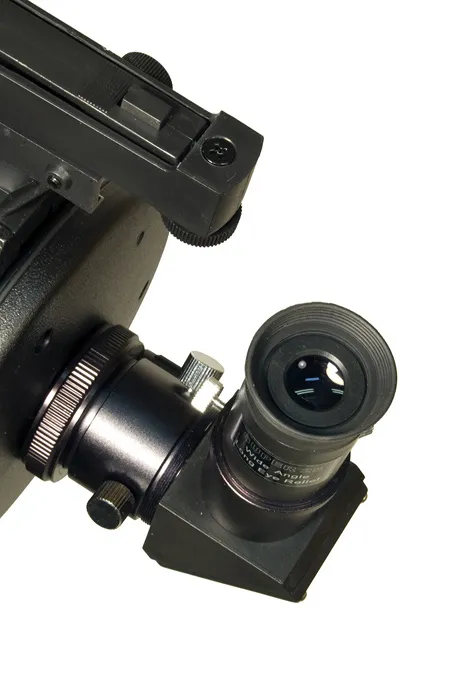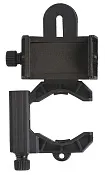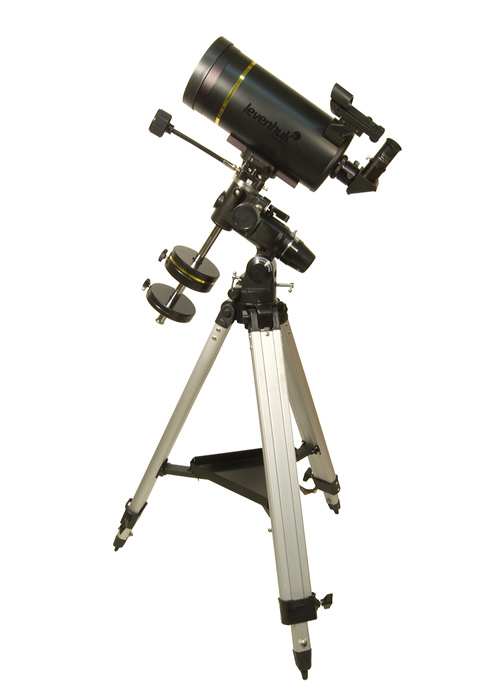Levenhuk Skyline PRO 127 MAK Telescope
Maksutov-Cassegrain telescope. Objective lens diameter: 127mm. Focal length: 1500mm
| Product ID | 28300 |
| Brand | Levenhuk, Inc., USA |
| Warranty | lifetime |
| EAN | 5905555002163 |
| Package size (LxWxH) | 115x50x25 cm |
| Shipping Weight | 20 kg |
Levenhuk Skyline PRO 127 MAK is the most powerful catadioptric telescope in the Skyline PRO series. A perfect blend of high-quality views and small dimensions of the tube is the main feature of the Maksutov-Cassegrain optical design. The long focal length and large aperture make this model perfect for planetary observations. With it you may observe the atmospheric flows of Jupiter, the gaps in rings of Saturn, the most prominent features of Mars’ surface, large and small craters and highlands features of the Moon, compact nebulae and star clusters. This model does not take up much space, so you can carry it easily and set it up wherever you find yourself. The mount accepts additional computerized drive systems and pole alignment finders, making it perfect for astrophotography.
The lenses and mirrors are fully multi-coated, which allows for maximum light gathering and increases their service life. The telescope tube is set up on an equatorial mount with slow-motion controls. You can also install dual-axis computerized drive system and a pole alignment finder (purchased separately) on your mount. It is equipped with setting circles which – after a quick adjustment – allow for locating objects by their celestial coordinates and tracking them with just a turn of an equatorial control. The adjustable height tripod has a practical accessory tray where you can store all your tools. Red Dot finder scope allows you to quickly navigate to the desired location.
The kit includes 10-millimeter (0.4-inch) and 25-millimeter (0.98-inch) eyepieces with 52-degree field of view of 150x and 60x magnification, respectively. The lenses are made of glass and are fully multi-coated. Focusing your telescope is as easy as adjusting the primary mirror with a move of the smooth-turning knob. You can use other eyepieces with this telescope, so that the assembly yields higher magnifications (keep in mind, however, that the highest practical power of this telescope is 250x).
Levenhuk Skyline PRO series was designed for advanced and demanding astronomers and includes a range of different models. The one thing in common is maximum precision and reliability during observations and astrophotography, high-quality materials and optics.
The kit includes:
- Telescope optical tube (optical elements inside)
- Red Dot finder scope
- Diagonal mirror
- 10mm eyepiece
- 25mm eyepiece
- Equatorial mount
- Tripod
- User manual and lifetime warranty
| Product ID | 28300 |
| Brand | Levenhuk, Inc., USA |
| Warranty | lifetime |
| EAN | 5905555002163 |
| Package size (LxWxH) | 115x50x25 cm |
| Shipping Weight | 20 kg |
| Optical design | catadioptric |
| Optical scheme | Maksutov-Cassegrain |
| Optics material | optical glass |
| Optics coating | standard |
| Primary mirror diameter (aperture), mm | 127 |
| Focal length, mm | 1500 |
| Highest practical power, x | 254 |
| Aperture ratio | f/11.8 |
| Resolution threshold, arcseconds | 1.1 |
| Limiting stellar magnitude | 12.5 |
| Eyepieces | SUPER 10mm (150x), SUPER 25mm (60x) |
| Eyepiece barrel diameter, in | 1.25 |
| Finderscope | red dot |
| Focuser | 1.25" |
| Tripod | aluminum |
| Tripod height (adjustable), mm | 700–1120 |
| Accessory tray | ✓ |
| Telescope control | manual |
| Mount | equatorial, EQ3 (3-2) |
| Power supply | CR2032 type battery – 1 pc. (not included) |
| User level | experienced users |
| Assembly and installation difficulty level | complicated |
| Observed object | deep-sky objects, planets of the Solar System |
Convenient diagrams that describe how to install additional accessories on refractors and catadioptric telescopes
Quick overview of all Levenhuk Skyline and Skyline PRO telescopes: telescopes' comparison and recommended use
Find out how to assemble a telescope on an example of the Levenhuk Skyline 90x900 EQ telescope
This short guide will help you avoid typical mistakes and learn more about telescope and mounting types
The basics of astronomical observations for beginners
In this article we have gathered answers to some of the most frequently asked questions about telescopes
The most interesting celestial objects you can observe with Levenhuk telescopes
How telescopes work?
You can actually perform observations from your balcony!
All about telescope sizes, types, magnification, and mounts
Learn how to set up and use the telescope properly
Astronomy in light-polluted skies. Find out what you can observe in the city
Read an interesting comprehensive article on telescopes for little astronomers
The pictures are made with Levenhuk telescopes
Celestial objects you can observe with telescopes of different apertures
Colored and vivid images of galaxies, planets and star clusters entrance everyone who is fascinated by boundless space
Find an interesting review on the history of the changes to a refracting telescope
To make the process of choosing a telescope easier, we will tell you about the characteristics of the most popular types of telescopes today
Learn everything you need to know about refractor telescopes to make the right choice
Yes, this model is very powerful but it can be used by beginners & amateurs as it comes with Maksutov-Cassegrain design.
No extra alignment are needed. The telescope can be used both in the city (with high light pollution) and countryside. The model is very compact, so can be easily transported.
You will be able to observe planents of our Solar system as well as deep sky.
Is there any additional information you might need?
The main difference between Levenhuk Skyline PRO 127 MAK telescope & Levenhuk Skymatic 127 MAK telescope is that the last one comes with the azimuth GoTo mount with a SynScan AZ hand controlle. The database of the Levenhuk Skymatic 127 MAK includes over 42000 objects.
The Skyline PRO 127 MAK comes with a German equatorial EQ3 mount.
Is there any additional information you might need?
Looking forward to your reply.
Refractors also can produce the effect of chromatic aberrations. Chromatic aberrations consist in dispersion of light passing through the optical system. White light is decomposed into its constituent color beams, whereby the object's images in different colors do not coincide to the images’ space. Chromatic aberration lead to reduced image sharpness, and sometimes also to the appearance of color contours, bands, spots that the object doesn't have in reality. For astronomers, this effect can alter the true color of the star. Chromatic aberration can increase the effect of spherical aberration. Coma is an off-axis aberration, associated with the slope of light rays coming from the source to the optical axis of the telescope. The image of the star will be in the form of a drop or comet with a bright core and a large tail.

